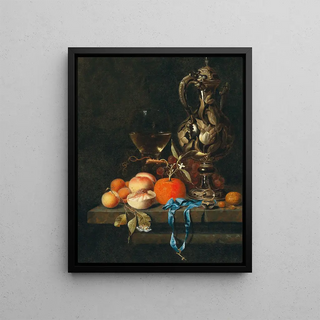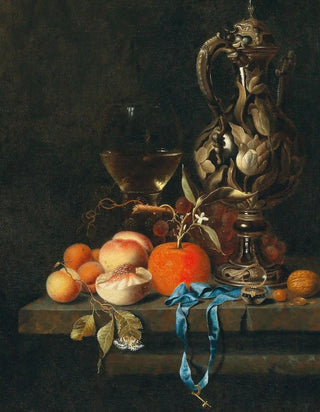Art print | Apricots, peaches and other fruits with glass and pitcher - Johannes Borman


View from behind

Frame (optional)
Reproduction of Apricots, Peaches, and Other Fruits with Glass and Pitcher - Johannes Borman – Engaging Introduction
In the rich and captivating universe of still life, the artwork "Apricots, Peaches, and Other Fruits with Glass and Pitcher" by Johannes Borman stands out for its delicacy and attention to detail. This composition, where light dances across the shiny surfaces of the fruits and glass, evokes a sense of freshness and vitality. The warm hues of the apricots and peaches, contrasting with the transparency of the pitcher, create a visual harmony that draws the eye and stimulates the imagination. Every element of this scene is carefully orchestrated, inviting the viewer to contemplate not only the beauty of the depicted objects but also the art of representation itself.
Style and uniqueness of the work
Borman's work is characterized by striking realism, where each fruit seems almost tangible, ready to be picked. His subtle use of light and shadow confers remarkable depth to the composition, allowing the forms to stand out from the background while remaining anchored in a palpable reality. This style, typical of the Dutch Golden Age of painting, demonstrates technical mastery that goes beyond simple representation. The delicate textures of the fruits, the reflection of the glass, and the way the colors blend harmoniously all testify to an artistic sensitivity that elevates this work to the level of masterpieces. The composition, while rooted in a classical tradition, also reveals a personal approach that makes Borman a fully-fledged artist.
The artist and his influence
Johannes Borman, active in the 17th century, is often regarded as a master of still life, a genre that experienced spectacular growth during this period. His ability to capture the ephemeral beauty of fruits and everyday objects reflects a broader trend in the art of his time, where artists sought to celebrate domestic life and simple pleasures. Borman's influence extends beyond his era, inspiring many contemporary artists who see in his works an invitation to explore the beauty of everyday life. Relying on refined painting techniques and a subtle palette, Borman has succeeded in creating

Matte finish

View from behind

Frame (optional)
Reproduction of Apricots, Peaches, and Other Fruits with Glass and Pitcher - Johannes Borman – Engaging Introduction
In the rich and captivating universe of still life, the artwork "Apricots, Peaches, and Other Fruits with Glass and Pitcher" by Johannes Borman stands out for its delicacy and attention to detail. This composition, where light dances across the shiny surfaces of the fruits and glass, evokes a sense of freshness and vitality. The warm hues of the apricots and peaches, contrasting with the transparency of the pitcher, create a visual harmony that draws the eye and stimulates the imagination. Every element of this scene is carefully orchestrated, inviting the viewer to contemplate not only the beauty of the depicted objects but also the art of representation itself.
Style and uniqueness of the work
Borman's work is characterized by striking realism, where each fruit seems almost tangible, ready to be picked. His subtle use of light and shadow confers remarkable depth to the composition, allowing the forms to stand out from the background while remaining anchored in a palpable reality. This style, typical of the Dutch Golden Age of painting, demonstrates technical mastery that goes beyond simple representation. The delicate textures of the fruits, the reflection of the glass, and the way the colors blend harmoniously all testify to an artistic sensitivity that elevates this work to the level of masterpieces. The composition, while rooted in a classical tradition, also reveals a personal approach that makes Borman a fully-fledged artist.
The artist and his influence
Johannes Borman, active in the 17th century, is often regarded as a master of still life, a genre that experienced spectacular growth during this period. His ability to capture the ephemeral beauty of fruits and everyday objects reflects a broader trend in the art of his time, where artists sought to celebrate domestic life and simple pleasures. Borman's influence extends beyond his era, inspiring many contemporary artists who see in his works an invitation to explore the beauty of everyday life. Relying on refined painting techniques and a subtle palette, Borman has succeeded in creating






